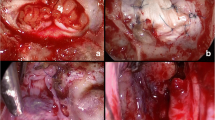Abstract
Purpose
The endoscopic endonasal approach is increasingly being used for resection and reconstruction of anterior skull base lesions. The vascularized nasoseptal flap (NSF) has become the workhorse for reconstruction of anterior skull base defects, resulting in a significant decrease in the incidence of cerebrospinal fluid (CSF) leak. This study presents a single center’s experience with NSFs and reports associated complications.
Methods
Patients who underwent endoscopic skull base defect repair with a NSF between 2008 and 2014 were retrospectively evaluated. Complications reviewed were divided into major and minor. Major complications included new-onset and continuing CSF leak and meningitis. Minor complications included long-standing crust formation, synechia, epistaxis, septal perforation, sinusitis and anosmia.
Results
Of the 77 patients included in the study, 47 (61%) underwent trans-sphenoidal surgery for pituitary lesions during which CSF leak was observed. The other 30 patients underwent reconstructive surgeries for post-traumatic CSF leaks or extirpation of lesions involving the anterior skull base. A high-flow intra-operative CSF leak was observed in 25 patients (25/77, 32%). The median follow-up was 16 months (range 3–81 months). 9 patients had major complications and 27 patients had minor complications. Only high-flow intra-operative CSF leak correlated with major complications (p = 0.012).
Conclusion
NSF is an extremely effective tool for skull base reconstruction. While it is associated with a low rate of major complications, minor complications are frequent and require local treatment, although they tend to resolve in the late postoperative period.



Similar content being viewed by others
References
Snyderman C, Kassam A, Carrau R, Mintz A, Gardner P, Prevedello DM (2007) Acquisition of surgical skills for endonasal skull base surgery: a training program. Laryngoscope 117:699–705
Cappabianca P, Cavallo LM, de Divitiis E (2004) Endoscopic endonasal transsphenoidal surgery. Neurosurgery 55:933–940 (Discussion 940–941)
Kassam AB, Prevedello DM, Carrau RL et al (2011) Endoscopic endonasal skull base surgery: analysis of complications in the authors’ initial 800 patients. J Neurosurg 114:1544–1568
Hadad G, Bassagasteguy L, Carrau RL et al (2006) A novel reconstructive technique after endoscopic expanded endonasal approaches: vascular pedicle nasoseptal flap. Laryngoscope 116:1882–1886
Kassam A, Carrau RL, Snyderman CH, Gardner P, Mintz A (2005) Evolution of reconstructive techniques following endoscopic expanded endonasal approaches. Neurosurg Focus 19:E8
Patel MR, Taylor RJ, Hackman TG et al (2014) Beyond the nasoseptal flap: outcomes and pearls with secondary flaps in endoscopic endonasal skull base reconstruction. Laryngoscope 12:846–852
Hu F, Gu Y, Zhang X et al (2015) Combined use of a gasket seal closure and a vascularized pedicle nasoseptal flap multilayered reconstruction technique for high-flow cerebrospinal fluid leaks after endonasal endoscopic skull base surgery. World Neurosurg 83:181–187
Lavigne P, Faden DL, Wang EW, Snyderman CH (2018) Complications of nasoseptal flap reconstruction: a systematic review. J Neurol Surg B Skull Base 79(suppl 4):S291–S299
Soudry E, Psaltis AJ, Lee KH, Vaezafshar R, Nayak JV, Hwang PH (2015) Complications associated with the pedicled nasoseptal flap for skull base reconstruction. Laryngoscope 125:80–85
Snyderman CH, Kassam AB, Carrau R, Mintz A (2007) Endoscopic reconstruction of cranial base defects following endonasal skull base surgery. Skull Base 17:73–78
Jalessi M, Jahanbakhshi A, Amini E et al (2016) Impact of nasoseptal flap elevation on sinonasal quality of life in endoscopic endonasal approach to pituitary adenomas. Eur Arch Otorhinolaryngol 273(5):1199–1205
Lai LT, Trooboff S, Morgan MK, Harvey RJ (2014) The risk of meningitis following expanded endoscopic endonasal skull base surgery: a systematic review. J Neurol Surg B Skull Base. 75:18–26
Van Aken MO, Feelders RA, de Marie S et al (2004) Cerebrospinal fluid leakage during transsphenoidal surgery: postoperative external lumbar drainage reduces the risk for meningitis. Pituitary 7:89–93
Coplin WM, Avellino AM, Kim DK, Winn HR, Grady MS (1999) Bacterial meningitis associated with lumbar drains: a retrospective cohort study. J Neurol Neurosurg Psychiatry 67:468–473
Eloy JA, Choudhry OJ, Friedel ME, Kuperan AB, Liu JK (2012) Endoscopic nasoseptal flap repair of skull base defects: is addition of a dural sealant necessary? Otolaryngol Head Neck Surg 147:161–166
Eloy JA, Kuperan AB, Choudhry OJ, Harirchian S, Liu JK (2012) Efficacy of the pedicled nasoseptal flap without cerebrospinal fluid (CSF) diversion for repair of skull base defects: incidence of postoperative CSF leaks. Int Forum Allergy Rhinol 2:397–401
Harvey RJ, Smith JE, Wise SK, Patel SJ, Frankel BM, Schlosser RJ (2008) Intracranial complications before and after endoscopic skull base reconstruction. Am J Rhinol 22:516–521
Kono Y, Prevedello DM, Snyderman CH et al (2011) One thousand endoscopic skull base surgical procedures demystifying the infection potential: incidence and description of postoperative meningitis and brain abscesses. Infect Control Hosp Epidemiol 32:77–83
Acknowledgements
Esther Eshkol, MA, institutional medical and scientific editor, is thanked for the editorial assistance.
Author information
Authors and Affiliations
Corresponding author
Ethics declarations
Conflict of interest
The authors declare that they have no conflict of interest.
Additional information
Publisher's Note
Springer Nature remains neutral with regard to jurisdictional claims in published maps and institutional affiliations.
Rights and permissions
About this article
Cite this article
Wengier, A., Ram, Z., Warshavsky, A. et al. Endoscopic skull base reconstruction with the nasoseptal flap: complications and risk factors. Eur Arch Otorhinolaryngol 276, 2491–2498 (2019). https://doi.org/10.1007/s00405-019-05531-4
Received:
Accepted:
Published:
Issue Date:
DOI: https://doi.org/10.1007/s00405-019-05531-4




